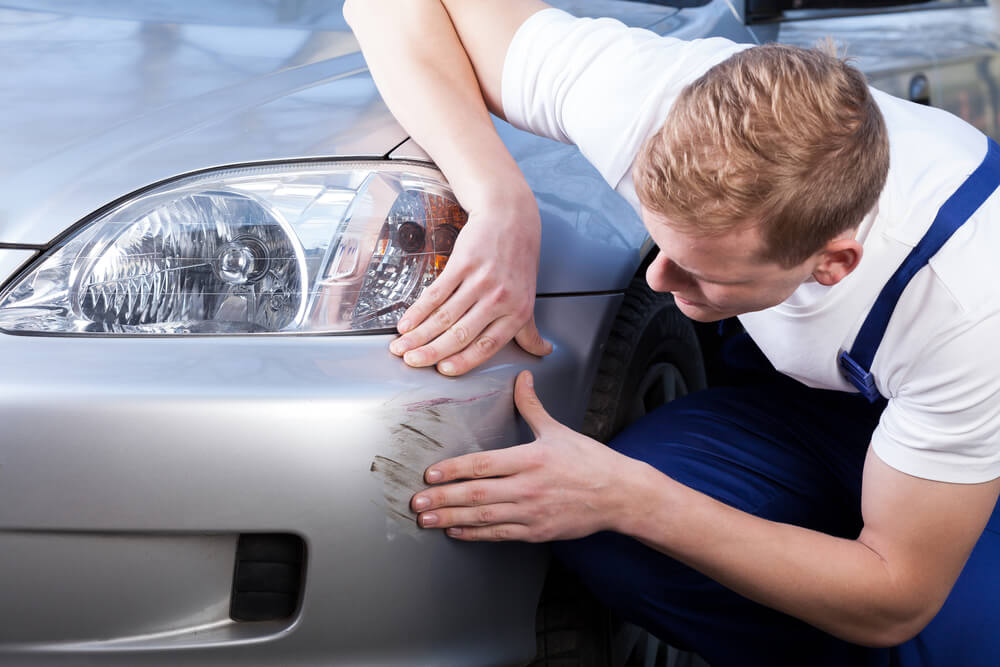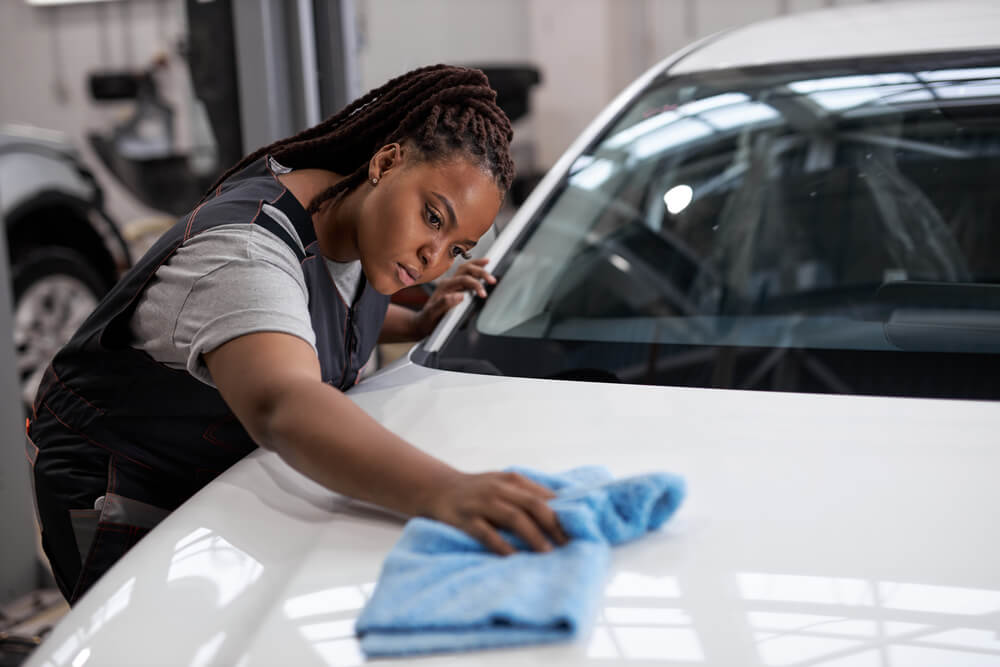
There are three main types of scratches that you can find on any car. We’ll discuss them all in this article and give you advice on different ways to treat them.
Cars are goods we use for our sole enjoyment and benefit. Sure, they are impressive feats of engineering that blow our minds away with their stunning design, technical features, sleek interiors, and fast speed. However, they are, after all, goods that can and will ultimately see signs of wear and tear, regardless of how much we try to protect them.
Some of the most common signs of wear and tear in cars are scratches. Scratches are a natural consequence of using your vehicle and can happen any time you’re driving, especially if you reside in a city.
They can occur in many ways, including hitting a curb, scraping against a tree, or being run over by another car. Scratches can also be caused by other things, such as insects nesting in your paint. Regardless of the cause, scratches can be unsightly and damaging to your car.
They might seem like a small detail, but they impact the resale value of your car later.
The good news is that scratches are easy to fix, as long as you catch them early enough. If the scratches are minor, you can take some steps to help reduce the appearance of these blemishes and make them less visible. Thankfully, no matter how big or small the scratch is, here’s some advice to help you get rid of it fast.
Types Of Scratches
Before we can talk about how to fix them, let’s first quickly look at the main types of scratches that can appear on cars.
There are three different types of scratches you may find on cars: surface scratches, deep scratches, and paint scratches.
Surface Scratches
Also called lighter scratches — the most common and least severe type of scratch. They are typically caused by dirt or rocks hitting the car’s surface. They tend to be shallow and can usually be buffed out with wax and polish.

Paint Scratches
Paint scratches are usually caused by another driver hitting your car with theirs. These types of scratches are the most difficult to fix and require repainting the affected area.
Deep Scratches
These are caused by more abrasive objects like keys or rocks, tend to go deeper into the car’s surface, and are harder to buff out. These types of scratches can also cause paint damage if they scrape off the top layer of paint.
Any car enthusiast will tell you that none of these are any better to have than the others since all types of scratches found on a car will affect its overall look and value.
How To Repair Different Types Of Scratches On Cars
Depending on the type of scratch and the extent of damage, there are three main options for repairing scratches: manual, chemical, and auto paint repair.
Manual Repair
If you have a scratch that’s shallow enough, you can attempt to fix it yourself by using items like toothpaste or baking soda. These products contain abrasive materials that can help gently remove light scratches from your car’s surface.
However, it’s important to note that manual repair methods should only be used for light scratches that don’t go too deep through the paint. In addition, regularly cleaning your car will also prevent dirt and debris from building up on its surface, causing further damage.
Chemical Repair
For deeper, or more serious scratches, a chemical repair may be more effective.
A chemical repair involves using an acidic solution to chemically etch away the affected area. The etching process is similar to sanding and polishing but uses an acid rather than sandpaper or a polishing compound.
After the affected area has been etched away, it’s filled in with paint or primer and then polished to restore the surface to its original condition.
Auto Paint Repair
If you have a deep scratch that goes all the way into your car’s paint, auto paint repair may be necessary.
Auto paint repair involves removing the damaged section of your car’s surface and replacing it with new paint. This can be done by manually removing the damaged paint or by using chemical etching methods to remove sections of your car’s paint down to bare metal before applying new paint. In addition, auto body shops can perform other services like dent repair and windshield replacement if necessary.
How To Fix Surface Scratches
Clear coat scratches are minor scratches that every car gets once in a while for several reasons. Among many things, these blemishes can be caused by rock chips touching the surface of the car or road debris that didn’t get washed on time. Improper washing with abrasive cleaners or rough materials can also lead to micro-scratches.
And since there are more types of scratches on cars, it’s important to first identify the ones you’re dealing with. You can do that easily with the fingernail test — if your fingernail doesn’t really go in the scratch, then it’s only a minor one that can be easily fixed and smoothed out.

The best way to fix this kind of scratch involves a polishing compound and a machine polisher that helps spread the compound evenly on the car’s clear coat.
How To Fix Paint Scratches
Once a scratch goes deeper than the clear coat, it reaches the paint coat itself. The clear coat is meant to come as an additional layer over the paint to protect it. So if you’re dealing with a scratch that cuts through this protective layer, you may need to roll up your sleeves a bit more to fix it. Different types of scratches on cars will require different solutions, so make sure you take notes.
1. First of all, wash and dry your car thoroughly.
2. Apply a high-quality scratch remover onto a foam applicator pad — I recommend Nexgen Scratch and Swirl Remover.
3. Use the pad to gently apply the product onto the scratches, ensuring it goes deep into the scratched surfaces.
4. When finished, buff out the treated area using a clean and dry microfiber cloth.
5. The very last step is to polish or wax the treated paint job, so you can restore it to the shine it deserves.
Primer Scratches
Before talking about primer scratches, we need to understand what primer is. Essentially, primer is another protective layer that covers the paint to shield it from all sorts of contaminants. Having said this, it’s important to remember that primer is applied as a layer that enables the paint to better stick onto the car’s surface.
Of all the different types of scratches on cars that you can fix by yourself, these are the most challenging to repair — but not impossible.
1. Thoroughly wash and dry your car. Use a professional wash soap and mitt to get the best results.
2. If there are multiple deep scratches, you may need to sand your car to apply a new coat of paint. What you need is low-grit sandpaper that can sand off all the imperfections and offer you a brand new canvas to play with. Look for 80-300 grit sandpaper — it should do the job just fine.
3. Get a piece of wood that you can wrap your sandpaper around and start sanding away. This is a task for the tough and brave, so gather your strength and energy before you do it.
4. If you only have one or two deeper primer scratches, you may be better off sanding and repainting locally. Regardless of which one of the three types of scratches on cars you have, you’ll still need to put your hands in the mix and try your best to fix it.
5. In both cases, you’ll need to know the color code of your previous paint layer so you know what to get when repainting. Either way, the worst scratches can be successfully dealt with by unapologetically sanding your car and stripping off everything.
Major Scratches: A PDR Job Or New Paint Job
If the scratches are very deep, you might want to consider getting a PDR job or a new paint job. A PDR job (Paintless Dent Removal) is a repairing process that uses tools to fill in the dents and scratches on your car’s paint. A new paint job is a drastic step, but it’s the only way to get rid of major scratches.
If the scratches are very deep, the paint shop might have to repaint the entire car. Keep in mind this process can be expensive. Moreover, it takes a long time, and your car will be out of service during that period.
Quick Tips To Prevent Scratches On Your Car
Clean Your Vehicle Regularly
First of all, clean your car regularly so that no dirt or debris could cause scratches when you’re cleaning. People often leave their car dirty for weeks and then try to clean it all in one go. This is a bad idea because the dirt will get into the paint and scratch the car. Instead, you should be cleaning your car regularly, even if only once a week. Use a good-quality microfiber towel to wipe down the car.
Microfiber is good because it’s soft, so it won’t scratch your paint. It’s also very absorbent, so it can soak up any liquids on the car’s surface.
You may also want to invest in a clay bar if you have heavily dirty areas on your car. Clay bars are great at removing surface dirt and grime without damaging the paint.
Park In a Well-Lit Area
This will help you see any hazards that might cause scratchings, such as small rocks or branches.
Get a Cover
Cover your car when not in use. If parking your car on the street, try covering it with a car cover to protect it from dirt and debris.
Use a Wax Or Sealant
Use a wax or sealant to protect your paint. Waxing your car or applying a sealant will protect your car from UV rays and prevent it from getting scratches.
Window Cleaning Matters Too
Clean your car’s windows regularly. Cleaning your car’s windows regularly will prevent dirt from building up on them and getting transferred to the paint as you drive.
Apply Ceramic Coating
You can prevent many scratches by simply applying ceramic coating — a strong protective layer that both shields your car’s paint from scratches and cuts and gives it a durable showroom shine. Choose a high-quality product like Nexgen Ceramic Spray, which is easy to apply and has more silicon dioxide than any other similar products, so you’re bound to get protection that actually lasts.
The Takeaway
If you own a vehicle, getting at least one of these types of scratches on your car is bound to happen over time, so it’s important to know that whatever you’re dealing with is quite fixable. All you need is the right tools and products by your side and the know-how to get you through the fixing process.
Hoping this guide on how to fix different types of scratches on your car will help you in the future, we think you might also enjoy:



